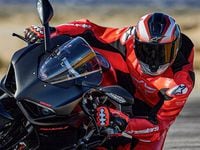In 1971, Bell introduced the Moto-3, the world’s first full-face motocross helmet. Before it, riders and brands affixed a variety of goggle and dust shield combinations to keep dust and roost out of their faces, but none of them added any safety to the mix.
The Moto-3 changed that, bringing full-face protection to the dirt.
At the time of its conception, the Moto-3 was designed to deliver the utmost in protection using the available technology. However, in the decades since, its design has also created a cult following in chopper and vintage circles.
Today, an entire cottage industry exists to refurbish and reline original examples to use again, not to mention the high price they demand on the used market.
Those of us who care about riding safety know that a helmet isn't much good five years after its creation, let alone 40, and these old eBay finds are about as safe as wearing a bag of flour on your head. And no, I don't care if you had it relined, being chopular isn't that important.
Add in the explosion of scramblers and other dirt-styled retro-modern motorcycles hitting dealerships and the burgeoning popularity of similar helmets like the Simpson M50, and the time was ripe to remake the Moto-3.
The question is—is it any good, or should it have been left in the history books?
Like the original, the new Moto-3's shell is fiberglass composite. However, 21st century advances in resins, moulds, modeling, and fiberglass layup technique make it significantly safer than its forebear.
The looks are almost identical, featuring a wide viewport, vented pug snout, and classically round silhouette. Like the Bullitt and 500, the Moto 3 is also three shell sizes, and weighs in less than 3 pounds. 2.5 on my scale in the Medium size.
Bell says the head shape is round, but like the 500 and Bullitt, it has been revised to be a bit more of an intermediate oval. MacD says his medium fits him far better than the Custom 500 or Bullitt, which he finds too round, and that they told him it was a revised headshape.
Like the Bell Bullitt, the Moto-3 has a multi-density EPS liner. And the Moto-3 is ECE/DOT certified - a significant safety upgrade over the original.
The liner is terrycloth and removable, just like the original, and that‘s pretty much it.
It has vents on the chin bar you can’t close, and five snaps for the included visor. Goggles are not included.
When it arrived, the first impression was the size of it and the quality. The paint is deep and without orange peel, and the shell size is tiny. Compared to my Bell Moto-9 or ICON Variant, it is positively invisible on my head.
The liner is ultra-plush and easy to remove, and I loved how soft it felt when I first put it on.
However, the visor is pretty brittle for something supposedly designed to hit the dirt. I thought I was going to shatter it just taking it off and putting it back on the helmet.
As for fitment, my head shape is somewhere between a round and intermediate oval and the Moto-3 is just a smidge too round for me, though not so much as to leave a mark.
For goggles, I iced the retro package with a pair of 100% Barstows. Then I hit the road.
Since goggles are crucial for comfort on a helmet without a shield, I tried both my 100% Barstows and Accuris. The Barstows, even though they’re designed as a retro piece to go with this type of helmet, are slightly too large for the eyeport, and it’s difficult to get a full seal with them. The smaller Accuris on the the hand fit fine.
Moto and ADV helmets are my go-to on the street. I enjoy the extra ventilation, the larger viewports, and the steeze that comes with them. I’m also pretty acclimated with the downsides.
The small shell size does wonders for the aerodynamics of the piece, but it does have a giant hole in your face, so wind noise and buffeting is expected and delivered.
When it comes to visor pull and the downsides of dirt-minded helmets on the pavement, it performed poorly compared to its modern equivalents. We can thank the lack of cutouts so the wind can pass through the visor, as are shown on the Moto-9 above.
The big trick if you’re going to wear dirt or ADV helmets on the street is to do head checks for lane changes by moving your head down and to the side, instead of side-to-side. Doing so significantly reduces the wind pulling on your head.
However, with the Moto-3, that vintage visor catches a ton of air regardless of what you do.
Above 60 mph and the visor starts to pull, above 85 and the world begins to blur.
I can wear my Moto-9 with significantly less discomfort, and my Variant is hardly noticeable at those speeds.
And here come the bigger downsides.
There are a few things that should have been left in 1971, namely the liner. All modern helmets, including Bells, spec a polyester or micro suede liner for a few reasons. Namely, they wick sweat, absorb heat so it feels cooler on your face, and are easy to clean.
The Moto-3 is a cotton terrycloth liner and does none of these things. You don’t often find terrycloth in motorcycle helmets anymore but, if you have a bathroom towel, you use the material all the time to dry off.
Bell claims this liner wicks sweat, but after a few gym trips it started to get significantly skunked. This is not the case with my Bell Moto-9.
It also picks up every speck of dirt that is on a surface when you put it down. On the BMW R nineT Scrambler launch, every time I put my helmet down somewhere it came back up with a layer of grime.
However, unlike the original Moto-3, this liner is removable so you can wash it.
Also, the Moto-3s with graphics do come with microsuede liners, and can be purchased separately, so I highly recommend getting a set from your dealer.
Secondly, you’d think with a giant hole in your face, venting wouldn’t be a problem. However, that’s where those tiny little holes in modern “power ranger” helmets come in.
People have the misconception that they’re just to force air in. However, they’re also there to help force air out in tandem with exhaust vents.
Your scalp is very thin, with a multitude of blood vessels. As air flows in, over, and out, air cools these vessels and makes you feel cooler than if you just had one constant blast of air to your face that stuck around inside the helmet.
The Moto-3 does not have either intake or exhaust vents for your scalp, only vents on the chin bar. This denies your head that cooling airflow, making you hot in athletic riding scenarios. Bopping around town this isn't an issue, but on the trail, or when it's really hot outside, you begin to sweat. A ton. Have you seen the pics of me from SoCal Supermoto? Yeah, like that.
But that’s also the nature of the helmet, what you see is what you get. Nobody buys these helmets for their technical superiority, so why even bother with those cons?
A little sweat is one thing, but let’s talk about the safety aspects of new helmets designed to look old.
The street doesn't care if you're dressed like Josh Kurpius or Josh Hayes. It's going to be just as hot and just as hard to hit, regardless of what you're wearing.
Vintage-designed helmets are often touted featuring “retro looks with modern performance.” That’s not an outright lie, but it’s not exactly the truth either. Often times they have the bare minimum of safety certifications, wonky fits, and middling build quality—all for premium prices.
But the Moto-3 comes close to a no-compromise solution.
It features a robust, EPS-lined chin bar in a field of unreinforced ones. Its shell size is tiny and doesn’t give you a bobblehead-look, and it’s ECE/DOT rated, not just DOT.
But it also features none of the current safety advancements made by Bell over the past 5 years, such as their FLEX liner, MIPS, or 3-D head shape modeling.
The Moto-3, and the rest of the retro field, are perfect sunny day helmets for rides under 45 mph, and under 80 degrees. In a situation like that, the advancements of modern helmets aren’t felt until it’s time for your head to hit the pavement.
And when your head hits, the Moto-3 is far and away one of the better options in this category because it is ECE/DOT certified and has a reinforced chin bar.
But when it rains, or is cold, or is humid, or you’re going fast, or you decide to thrash off road—you’ll really want to reach for the comfort of a modern helmet.
I’m a gear snob. Unabashed. I’m also incredibly vain. These two traits often times run into each other at headlong speed. The Moto-3 is their moment of collision.
At $349.99 + goggles, you’re in real helmet money. My Bell Moto-9 is $399.95. My ICON Variant is $370, and they both feature multi-density EPS’, modern venting, sweat-wicking liners, and better aerodynamics.
But, as noted, I am a hopeless fashion victim.
So when I was sent to the R nineT Scrambler launch, I reached for my Moto 3. When heading out to work, on a sunny day, I grab my Moto 3.
But every time I reach for this helmet, I do so highly cognizant that I am making a compromise in safety and feature set. And you should be aware of this too.
Luckily though, it features the fewest compromises in its class, and that’s why I recommend it for anyone whose head shape fits it and doesn't want to look like a moto bro.
But really, have you tried looking like a moto bro? It’s pretty awesome, way more comfortable, and safer, too.











/cloudfront-us-east-1.images.arcpublishing.com/octane/7ED4YDQHDRHCJFVAPG5ZFYJ46U.jpg)
/cloudfront-us-east-1.images.arcpublishing.com/octane/HXQWMP6MSBEPVP46S2IY6R5IWQ.jpg)
/cloudfront-us-east-1.images.arcpublishing.com/octane/MADE3NM5WFAETEANGBZNJHABEM.jpg)
/cloudfront-us-east-1.images.arcpublishing.com/octane/NUSK47VSUVHSTEDXD4ZJABA2AY.jpg)
/cloudfront-us-east-1.images.arcpublishing.com/octane/RKRXFE643JG47HOJGONO5ODMQM.jpg)
/cloudfront-us-east-1.images.arcpublishing.com/octane/D457ILAVDFDA3PYYOFXUBFX7DI.jpg)
/cloudfront-us-east-1.images.arcpublishing.com/octane/6AL7R7BR3NGEBM6S4SUNLX3S4U.jpg)
/cloudfront-us-east-1.images.arcpublishing.com/octane/XTZJP2LA2VDPLELKK34OX3L2DU.jpg)
/cloudfront-us-east-1.images.arcpublishing.com/octane/YYFQWTF6R5A5ZLKSFPOBHIUAXA.jpg)
/cloudfront-us-east-1.images.arcpublishing.com/octane/RMCT2KVQBJHBZMRTSLOVPMOILU.jpg)

/cloudfront-us-east-1.images.arcpublishing.com/octane/K45KB2XHQVA65DX7VN4ZSMT2BI.jpg)
/cloudfront-us-east-1.images.arcpublishing.com/octane/BIVAK2SFIBDJJM25E7I5VU2FJE.jpg)
/cloudfront-us-east-1.images.arcpublishing.com/octane/FNHXQQ56BRD7TO4YIJ453PNG2M.jpg)
/cloudfront-us-east-1.images.arcpublishing.com/octane/OIKJC4JA3ZH7BMKUGWYKBIY5FA.jpg)
/cloudfront-us-east-1.images.arcpublishing.com/octane/MT2SAEWY6FDXFBYSLDE3AEFDTM.jpg)
/cloudfront-us-east-1.images.arcpublishing.com/octane/66UPKPYVURBPRCP5HXSN56MEMM.jpg)
/cloudfront-us-east-1.images.arcpublishing.com/octane/EOREGDSRKFDCRJC6K3EDVHBGCE.jpg)
/cloudfront-us-east-1.images.arcpublishing.com/octane/42RF63Q3LVCMBP3DGTWXFYSMOA.jpg)
/cloudfront-us-east-1.images.arcpublishing.com/octane/XNVY3EVWZFCEVPUGJGAN633LXE.jpg)
/cloudfront-us-east-1.images.arcpublishing.com/octane/2PLTVHXY7FDSPFHKU5CFOC43ZY.jpg)
/cloudfront-us-east-1.images.arcpublishing.com/octane/B6M3WTRLFZGNXBEATNXPVGBBD4.jpg)
/cloudfront-us-east-1.images.arcpublishing.com/octane/4CMH3FI73BEM5D6MFYX42FLDSQ.jpg)
/cloudfront-us-east-1.images.arcpublishing.com/octane/RIHAPYNWU5H3XAOXNOPRWCBTQA.jpg)
/cloudfront-us-east-1.images.arcpublishing.com/octane/HU4NUBCL3VAFZA75VYRCMAUHVM.jpg)
/cloudfront-us-east-1.images.arcpublishing.com/octane/OB43AZK7TRA6XLZL5WRDVW2TDA.jpg)
/cloudfront-us-east-1.images.arcpublishing.com/octane/5G44Y3FXWNFSTEQKCA355PXOPU.jpg)

/cloudfront-us-east-1.images.arcpublishing.com/octane/XRI4GTLCVBA5NESASCBIR5LYQI.jpg)
/cloudfront-us-east-1.images.arcpublishing.com/octane/EF7566PXARGMBAOMLWTECYL3LE.jpg)


